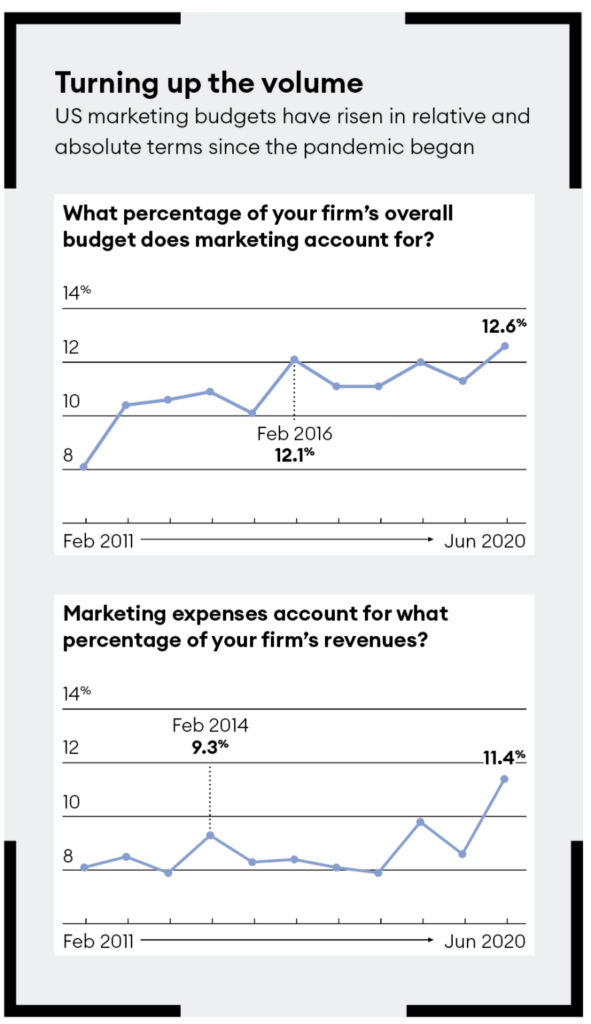The pandemic highlighted the key role marketing departments play for their businesses. And that’s reflected in the numbers.
When Professor Christine Moorman pored over the results of her 2020 survey of chief marketing officers, she spotted something remarkable. In a year of intense crisis, of cutbacks, of pandemic-triggered economic panic, marketing budgets had gone up. “I was surprised,” Moorman tells the Chartered Institute of Marketing’s podcast in the UK. “Then all the pieces of this came together.” The average rise in budgets was 5%. Some 41% of US companies allocated greater budgets to their marketing departments; 30% made no change on the year before and only 28% made cuts. “There were winners and losers,” says Moorman, the T Austin Finch senior professor of business administration at Duke University’s Fuqua School of Business, who founded the survey and has led it since its inception.
The survey has asked American chief marketing officers (CMOs) the same budgetary questions since the survey began: ‘What percentage of your firm’s overall budget does marketing account for?’ and ‘What percentage of your firm’s revenue does your marketing budget account for?’ In the 2020 data, “Both of those numbers were the highest we have seen in the entire history of the survey,” says Moorman. “What that means is that as revenues and the firm’s overall budgets have dropped, marketing budgets didn’t drop at the same rate. In fact, they lifted.” Since February 2020, the proportion of the average firm’s overall marketing budget rose by 12% (1.3 percentage points) in terms of overall budget, and by 33% (2.8 points) in relation to its revenue.

The surprise uptick in budgets is set against market sentiment that is the lowest since the Great Crash of 2008. “We get a really interesting longitudinal view on sentiment on the CMO Survey,” says Moorman. On a scale of one to 100, marketers’ sentiment in February stood at just 50.9. “It was 47.9 in February 2009, just after the great recession took hold,” says Moorman. “We climbed out – but we climbed back in.”
Yet despite the almost universal picture of misery, marketing became more important to companies as a result of the pandemic. Almost two-thirds of marketers told the survey that the crisis had shone a light on the critical role marketing departments play. “We were in a lockdown situation where you couldn’t go out and the means of communication was through phone or digital channels – suddenly engagement with customers became more important to keep your brand out there and to keep the conversations going,” Gemma Butler, director of marketing at the Chartered Institute of Marketing (CIM) tells the podcast. There was the need to remind customers that companies were still operating, adds Butler; to demonstrate how modes of delivery will change and to offer an ongoing dialogue of support. Those three factors made marketing’s role critical, she says: many firms decided, “It was the time to amplify their voice.”
Missed opportunities
Marketing played a crucial role, yet the survey reveals that it missed several chances to carve out opportunities born of the crisis. When Moorman and her team asked marketers what they prioritized, they “only weakly” prioritized expanding into new offerings and building new partnerships. “When I think about marketing, I think about growth,” she says. “Even during a difficult time, this would have been an opportunity to use employees to explore new opportunities, to use new partnerships to create more value.”
In fact, much marketing activity was essentially defensive – holding on to the customers’ companies already had, rather than finding new ones. Moorman says: “If you believe that necessity is the mother of invention, it might have been the case that, in a constrained environment, employees might have been very engaged and interested in helping invent new products and services.” Yet for most companies, the opportunity was spurned.
The tech sector was the honourable exception – it did explore new avenues and sought opportunities. “If I had to point to one sector – when we look across a number of behaviours, they seemed to be more on the cutting edge,” Moorman says. Yet outward-looking agility need not be the preserve of techs, she adds. “One of the things we have seen about marketing over time,” she says, “is that it does pivot and, if done well, it brings the focus back to the customer.”
Is she optimistic for the future? “Yes. Marketing has to think about novel forms of growth. There are interesting opportunities out there. I’m very hopeful. We asked about the skillsets that marketers would prioritize, and one of them was to pivot to take advantage of opportunities. It’s time to pivot away.”




